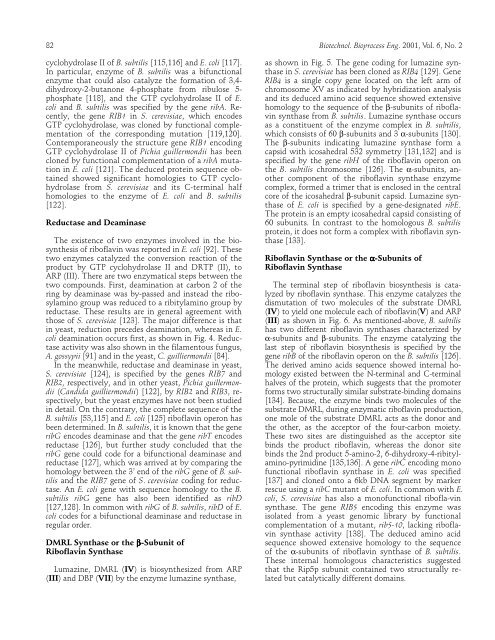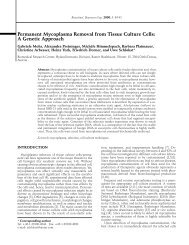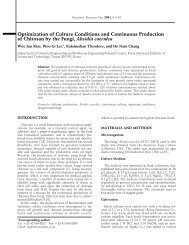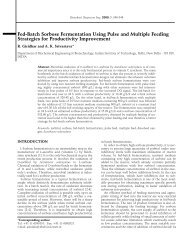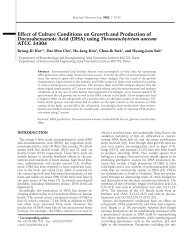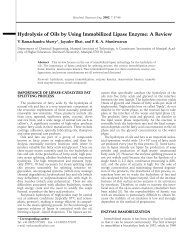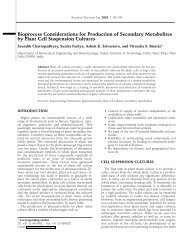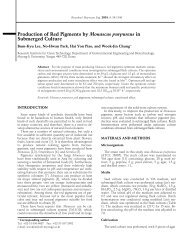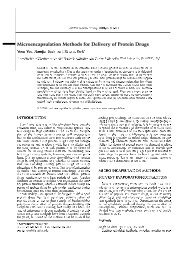Microbial Production of Riboflavin Using Riboflavin Overproducers ...
Microbial Production of Riboflavin Using Riboflavin Overproducers ...
Microbial Production of Riboflavin Using Riboflavin Overproducers ...
Create successful ePaper yourself
Turn your PDF publications into a flip-book with our unique Google optimized e-Paper software.
82 Biotechnol. Bioprocess Eng. 2001, Vol. 6, No. 2<br />
cyclohydrolase II <strong>of</strong> B. subtilis [115,116] and E. coli [117].<br />
In particular, enzyme <strong>of</strong> B. subtilis was a bifunctional<br />
enzyme that could also catalyze the formation <strong>of</strong> 3,4-<br />
dihydroxy-2-butanone 4-phosphate from ribulose 5-<br />
phosphate [118], and the GTP cyclohydrolase II <strong>of</strong> E.<br />
coli and B. subtilis was specified by the gene ribA. Recently,<br />
the gene RIB1 in S. cerevisiae, which encodes<br />
GTP cyclohydrolase, was cloned by functional complementation<br />
<strong>of</strong> the corresponding mutation [119,120].<br />
Contemporaneously the structure gene RIB1 encoding<br />
GTP cyclohydrolase II <strong>of</strong> Pichia guillermondii has been<br />
cloned by functional complementation <strong>of</strong> a ribA mutation<br />
in E. coli [121]. The deduced protein sequence obtained<br />
showed significant homologies to GTP cyclohydrolase<br />
from S. cerevisiae and its C-terminal half<br />
homologies to the enzyme <strong>of</strong> E. coli and B. subtilis<br />
[122].<br />
Reductase and Deaminase<br />
The existence <strong>of</strong> two enzymes involved in the biosynthesis<br />
<strong>of</strong> rib<strong>of</strong>lavin was reported in E. coli [92]. These<br />
two enzymes catalyzed the conversion reaction <strong>of</strong> the<br />
product by GTP cyclohydrolase II and DRTP (II), to<br />
ARP (III). There are two enzymatical steps between the<br />
two compounds. First, deamination at carbon 2 <strong>of</strong> the<br />
ring by deaminase was by-passed and instead the ribosylamino<br />
group was reduced to a ribitylamino group by<br />
reductase. These results are in general agreement with<br />
those <strong>of</strong> S. cerevisiae [123]. The major difference is that<br />
in yeast, reduction precedes deamination, whereas in E.<br />
coli deamination occurs first, as shown in Fig. 4. Reductase<br />
activity was also shown in the filamentous fungus,<br />
A. gossypii [91] and in the yeast, C. guilliermondii [84].<br />
In the meanwhile, reductase and deaminase in yeast,<br />
S. cerevisiae [124], is specified by the genes RIB7 and<br />
RIB2, respectively, and in other yeast, Pichia guillermondii<br />
(Candida guilliermondii) [122], by RIB2 and RIB3, respectively,<br />
but the yeast enzymes have not been studied<br />
in detail. On the contrary, the complete sequence <strong>of</strong> the<br />
B. subtilis [53,115] and E. coli [125] rib<strong>of</strong>lavin operon has<br />
been determined. In B. subtilis, it is known that the gene<br />
ribG encodes deaminase and that the gene ribT encodes<br />
reductase [126], but further study concluded that the<br />
ribG gene could code for a bifunctional deaminase and<br />
reductase [127], which was arrived at by comparing the<br />
homology between the 3’ end <strong>of</strong> the ribG gene <strong>of</strong> B. subtilis<br />
and the RIB7 gene <strong>of</strong> S. cerevisiae coding for reductase.<br />
An E. coli gene with sequence homology to the B.<br />
subtilis ribG gene has also been identified as ribD<br />
[127,128]. In common with ribG <strong>of</strong> B. subtilis, ribD <strong>of</strong> E.<br />
coli codes for a bifunctional deaminase and reductase in<br />
regular order.<br />
DMRL Synthase or the β-Subunit <strong>of</strong><br />
Rib<strong>of</strong>lavin Synthase<br />
Lumazine, DMRL (IV) is biosynthesized from ARP<br />
(III) and DBP (VII) by the enzyme lumazine synthase,<br />
as shown in Fig. 5. The gene coding for lumazine synthase<br />
in S. cerevisiae has been cloned as RIB4 [129]. Gene<br />
RIB4 is a single copy gene located on the left arm <strong>of</strong><br />
chromosome XV as indicated by hybridization analysis<br />
and its deduced amino acid sequence showed extensive<br />
homology to the sequence <strong>of</strong> the β-subunits <strong>of</strong> rib<strong>of</strong>lavin<br />
synthase from B. subtilis. Lumazine synthase occurs<br />
as a constituent <strong>of</strong> the enzyme complex in B. subtilis,<br />
which consists <strong>of</strong> 60 β-subunits and 3 α-subunits [130].<br />
The β-subunits indicating lumazine synthase form a<br />
capsid with icosahedral 532 symmetry [131,132] and is<br />
specified by the gene ribH <strong>of</strong> the rib<strong>of</strong>lavin operon on<br />
the B. subtilis chromosome [126]. The α-subunits, another<br />
component <strong>of</strong> the rib<strong>of</strong>lavin synthase enzyme<br />
complex, formed a trimer that is enclosed in the central<br />
core <strong>of</strong> the icosahedral β-subunit capsid. Lumazine synthase<br />
<strong>of</strong> E. coli is specified by a gene-designated ribE.<br />
The protein is an empty icosahedral capsid consisting <strong>of</strong><br />
60 subunits. In contrast to the homologous B. subtilis<br />
protein, it does not form a complex with rib<strong>of</strong>lavin synthase<br />
[133].<br />
Rib<strong>of</strong>lavin Synthase or the α-Subunits <strong>of</strong><br />
Rib<strong>of</strong>lavin Synthase<br />
The terminal step <strong>of</strong> rib<strong>of</strong>lavin biosynthesis is catalyzed<br />
by rib<strong>of</strong>lavin synthase. This enzyme catalyzes the<br />
dismutation <strong>of</strong> two molecules <strong>of</strong> the substrate DMRL<br />
(IV) to yield one molecule each <strong>of</strong> rib<strong>of</strong>lavin(V) and ARP<br />
(III) as shown in Fig. 6. As mentioned-above, B. subtilis<br />
has two different rib<strong>of</strong>lavin synthases characterized by<br />
α-subunits and β-subunits. The enzyme catalyzing the<br />
last step <strong>of</strong> rib<strong>of</strong>lavin biosynthesis is specified by the<br />
gene ribB <strong>of</strong> the rib<strong>of</strong>lavin operon on the B. subtilis [126].<br />
The derived amino acids sequence showed internal homology<br />
existed between the N-terminal and C-terminal<br />
halves <strong>of</strong> the protein, which suggests that the promoter<br />
forms two structurally similar substrate-binding domains<br />
[134]. Because, the enzyme binds two molecules <strong>of</strong> the<br />
substrate DMRL, during enzymatic rib<strong>of</strong>lavin production,<br />
one mole <strong>of</strong> the substrate DMRL acts as the donor and<br />
the other, as the acceptor <strong>of</strong> the four-carbon moiety.<br />
These two sites are distinguished as the acceptor site<br />
binds the product rib<strong>of</strong>lavin, whereas the donor site<br />
binds the 2nd product 5-amino-2, 6-dihydroxy-4-ribitylamino-pyrimidine<br />
[135,136]. A gene ribC encoding mono<br />
functional rib<strong>of</strong>lavin synthase in E. coli was specified<br />
[137] and cloned onto a 6kb DNA segment by marker<br />
rescue using a ribC mutant <strong>of</strong> E. coli. In common with E.<br />
coli, S. cerevisiae has also a mon<strong>of</strong>unctional rib<strong>of</strong>la-vin<br />
synthase. The gene RIB5 encoding this enzyme was<br />
isolated from a yeast genomic library by functional<br />
complementation <strong>of</strong> a mutant, rib5-10, lacking rib<strong>of</strong>lavin<br />
synthase activity [138]. The deduced amino acid<br />
sequence showed extensive homology to the sequence<br />
<strong>of</strong> the α-subunits <strong>of</strong> rib<strong>of</strong>lavin synthase <strong>of</strong> B. subtilis.<br />
These internal homologous characteristics suggested<br />
that the Rip5p subunit contained two structurally related<br />
but catalytically different domains.


